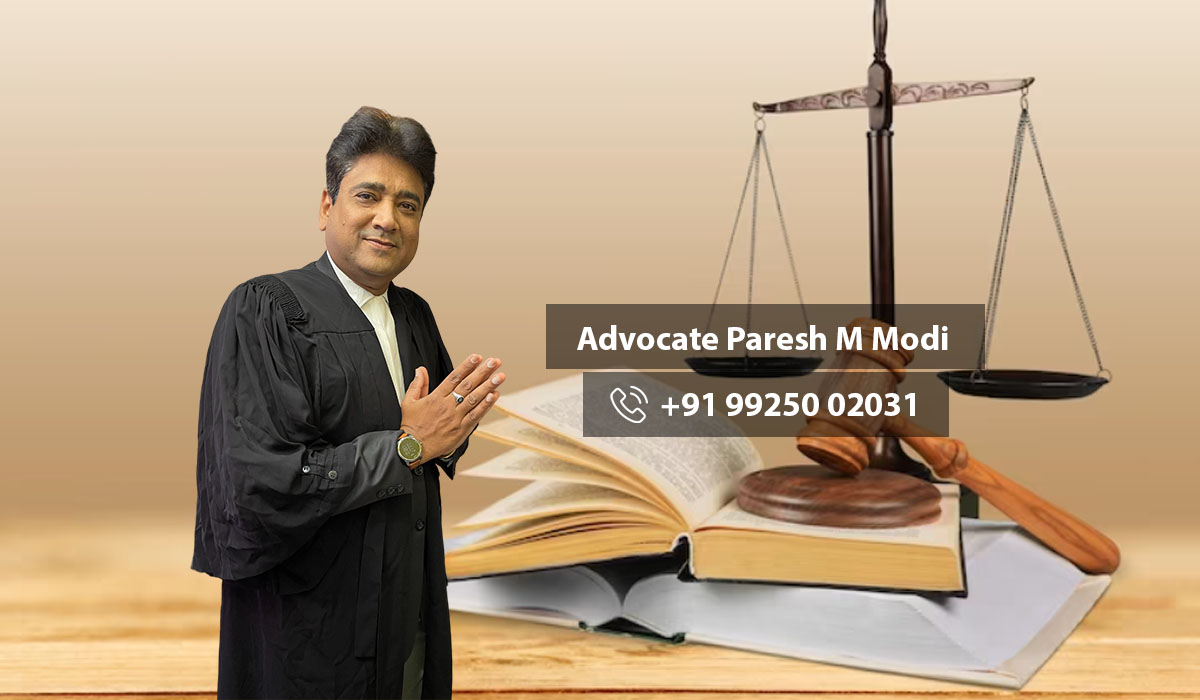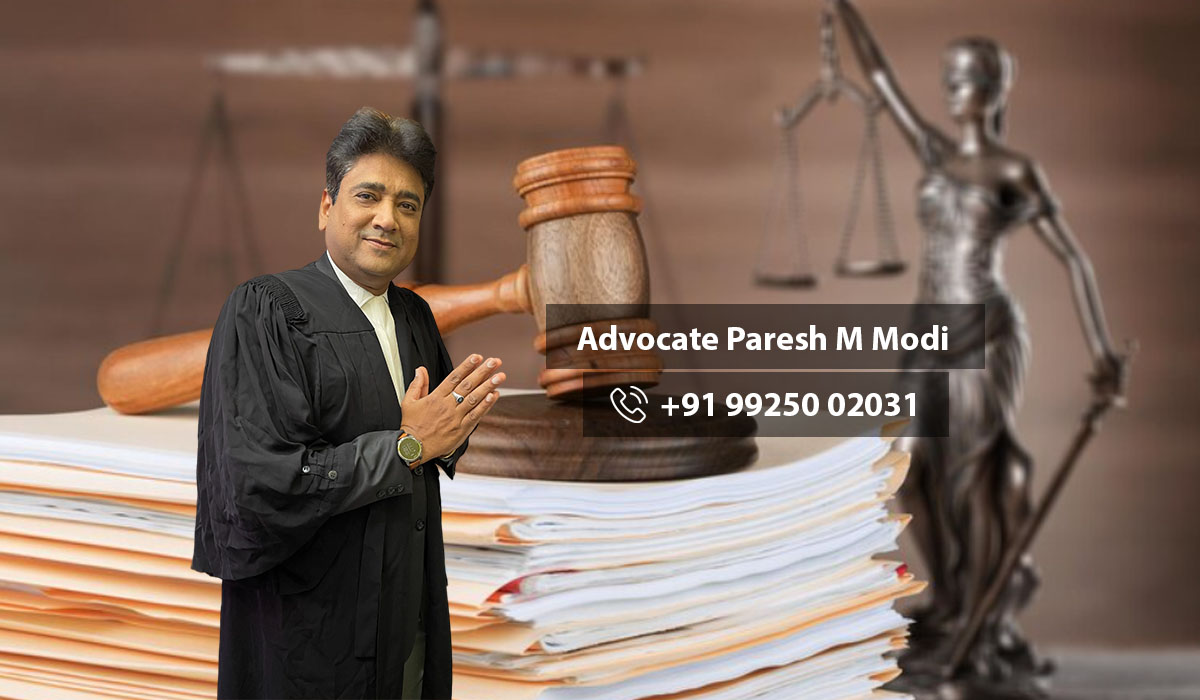Charity Commissioner and his Power, Process of sale the property of Trust in Gujarat | Advocate Paresh M Modi | 9925002031
Here is a comprehensive and detailed explanation regarding the Charity Commissioner in India (particularly Gujarat) and their powers, responsibilities, jurisdictions, and the legal process involved in managing Trusts and Trust Properties — including sale, transfer, and change of trustees:
📜 1. Legal Framework: Bombay Public Trusts Act, 1950 (Applicable to Gujarat)
The office of the Charity Commissioner operates under the provisions of the Bombay Public Trusts Act, 1950 (BPT Act), which is extended to Gujarat. The Charity Commissioner has quasi-judicial powers and supervises the functioning of all registered public trusts in the state.
⚖️ 2. Powers of the Charity Commissioner
Under various sections of the BPT Act, the Charity Commissioner has extensive powers to ensure accountability, transparency, and lawful administration of public charitable and religious trusts. Key powers include:
a) Registration of Trusts (Sections 18-22)
Every public trust must be registered with the Charity Commissioner.
Details like name, object, trustees, and property of the trust must be submitted.
b) Supervision and Control (Section 36B & 41A)
Charity Commissioner can inspect accounts and records.
Can issue directions to trustees to ensure proper administration.
c) Enquiries (Sections 22, 22A, 22B)
Power to hold inquiries regarding changes in trust particulars like trustees, property, etc.
Can direct changes in the trust register after an inquiry.
d) Power to Approve Sale/Alienation of Trust Property (Section 36)
No immovable trust property can be sold, exchanged, or gifted without prior permission from the Charity Commissioner.
This ensures the property is not alienated in a manner prejudicial to the trust’s purpose.
e) Framing and Modification of Schemes (Section 50A)
Can frame or modify a scheme for proper administration of a trust.
Often used when disputes arise among trustees.
f) Power to Suspend or Remove Trustees (Section 41D)
If a trustee is guilty of misconduct, breach of trust, or mismanagement.
g) Initiating Legal Action (Section 50)
Can sue for recovery of possession of trust property, breaches of trust, etc.
🗺️ 3. Working Area and Jurisdiction
The Charity Commissioner has state-wide jurisdiction and operates through regional and sub-regional offices (like in Ahmedabad, Rajkot, Vadodara, Surat, etc.).
District-level Deputy or Assistant Charity Commissioners handle local trust matters.
Appeals against orders of Assistant or Deputy Charity Commissioners lie with the Charity Commissioner.
💼 4. Role Regarding Trust Property
a) Protection of Trust Property
Ensures that trust property is used only for the trust’s objectives.
Prevents unauthorized sale, lease, or transfer.
b) Permission for Sale/Lease (Section 36)
The trustee must:
Apply in prescribed form with reasons.
Attach valuation report and proposed buyer details.
Notify the public (often via newspaper) and invite objections.
Charity Commissioner may grant or reject permission after inquiry.
✅ Without prior permission, any sale or lease is void ab initio (null and void).
🔁 5. Process to Sell or Transfer Trust Property
Step-by-Step:
Resolution by Trust Board: Trustees pass a resolution expressing intent to sell property.
Application to Charity Commissioner (Form Schedule II-A):
Details of the property, valuation, reason for sale, expected price.
Notice and Inquiry:
Public notice issued.
Objections (if any) heard.
Personal hearing to trustees and objectors.
Order by Charity Commissioner:
Permission granted with or without conditions, or rejected.
Execution of Sale Deed:
Once permission is obtained, the sale is registered legally.
🔄 6. Transfer/Change of Trustees
a) Reasons for Change:
Death, resignation, disqualification, removal, or expiration of term.
b) Process:
Trust Resolution: Record the change in meeting minutes.
Form Change Report (Schedule III):
Filed before the Deputy or Assistant Charity Commissioner.
Must be submitted within 90 days of change.
Notice and Inquiry (Section 22):
Public notice issued.
Inquiry conducted to ensure no fraud or illegality.
Order of Change: Entry in the Public Trust Register (PTR) is amended.
📝 Note: If trustees are being removed/replaced due to disputes or misconduct, the Charity Commissioner can initiate proceedings under Sections 41A or 41D.
⚖️ 7. Legal Remedies and Appeal
Appeal against the order of Assistant or Deputy Charity Commissioner lies with the Charity Commissioner (Section 70).
Further appeal lies with the Gujarat Revenue Tribunal (GRT) or through writ petition before the Gujarat High Court under Article 226 of the Constitution.
🧾 8. Trustee Liabilities and Duties
Act in good faith and with reasonable care.
Use trust property only for declared objectives.
Maintain proper accounts and file annual returns.
Liable for misappropriation, negligence, or breach of trust.
📌 Summary Chart
| Subject | Provision/Section | Authority |
|---|---|---|
| Registration of Trust | Section 18 | Assistant Charity Commissioner |
| Sale of Immovable Property | Section 36 | Charity Commissioner |
| Change in Trustees | Sections 22, 22A | Deputy/Assistant Charity Comm. |
| Supervision & Directions | Sections 41A, 36B | Charity Commissioner |
| Legal Suit for Mismanagement | Section 50 | Charity Commissioner |
| Scheme for Trust Admin | Section 50A | Charity Commissioner |
📞 For Legal Help in Gujarat
If you are involved in trust matters in Gujarat, especially in Dholera, Ahmedabad, or surrounding regions, you can consult:
Advocate Paresh M Modi
📍 Office No. C/112, Supath-2 Complex, Opp. Kohinoor Plaza Hotel, Near Old Wadaj Bus Stand, Aashram Road, Ahmedabad – 380013
📞 Mobile: +91 9925002031
📠 Office: +91-79-48001468
📧 Email: advocatepmmodi@gmail.com
🌐 Website: www.advocatepmmodi.in
IN GUJARATI LANGUAGE
ચેરિટી કમિશનર અને તેમની સત્તા, ગુજરાતમાં ટ્રસ્ટની મિલકતના વેચાણની પ્રક્રિયા | એડવોકેટ પરેશ એમ મોદી | 9925002031
અહીં ચેરિટી કમિશ્નરશ્રીની શક્તિઓ, કામકાજનો વિસ્તાર, જવાબદારી, વિશ્વાસ સંપત્તિ (Trust Property) બાબત અધિકારો તથા વિશ્વાસ સંપત્તિને વેચવાના અથવા ટ્રાન્સફર કરવાના પ્રક્રિયાના વિગતવાર Gujarati ભાષામાં વર્ણન છે:
📜 1. કાયદાકીય ધોરણ – બોમ્બે પબ્લિક ટ્રસ્ટ એક્ટ, 1950 (ગુજરાત માટે લાગુ)
ચેરિટી કમિશ્નરશ્રીનો કાર્યક્ષેત્ર “Bombay Public Trusts Act, 1950” હેઠળ આવરી લેવાયો છે, જે ગુજરાત રાજ્યમાં અમલમાં છે. આ અધિનિયમ હેઠળ દરેક જાહેર અને ધર્માદા વિશ્વાસ (Public Charitable Trust) નું નોધણીકરણ ફરજિયાત છે.
⚖️ 2. ચેરિટી કમિશ્નરશ્રીની શક્તિઓ (Powers)
✅ મુખ્ય જુક્તીઓ:
વિશ્વાસનું રજિસ્ટ્રેશન (ધારા 18-22): દરેક ટ્રસ્ટનું નોધણીકરણ ચેરિટી કમિશ્નરશ્રીના કચેરીમાં કરવું ફરજિયાત છે.
વિશ્ર્વાસની દેખરેખ અને નિયંત્રણ (ધારા 36B અને 41A): ટ્રસ્ટના હિસાબ/રેકોર્ડ ચકાસવાની અને જરૂરી સૂચનાઓ આપવાની શક્તિ.
વિશ્ર્વાસ સંપત્તિ વેચવા મંજૂરી (ધારા 36): કોઇપણ અસ્થાવર (Immovable) ટ્રસ્ટ સંપત્તિને વેચવા માટે ચેરિટી કમિશ્નરની પૂર્વ મંજૂરી ફરજિયાત છે.
વિશ્વાસના કામકાજ માટે યોજના તૈયાર કરવી (ધારા 50A): ટ્રસ્ટમાં વિવાદ કે દુરવ્યવસ્થાના સમયે વ્યવસ્થાપન માટે નવી યોજના ઘડવી.
ટ્રસ્ટીઓ હટાવવાની શક્તિ (ધારા 41D): દુર્વ્યવહાર, ભ્રષ્ટાચાર કે બેદરકારી બદલ ટ્રસ્ટી હટાવવાનો હક્ક.
દાવા દાખલ કરવાની શક્તિ (ધારા 50): ટ્રસ્ટની સંપત્તિ પાછી મેળવવા કે ભ્રષ્ટાચાર સામે દાવા.
🗺️ 3. કાર્ય વિસ્તાર અને અધિકારક્ષેત્ર (Jurisdiction)
ચેરિટી કમિશ્નરશ્રીની કચેરી ગુજરાત રાજ્ય માટે રાજ્યવ્યાપી છે.
દરેક જિલ્લામાં ડિપ્યુટી અથવા આસિસ્ટન્ટ ચેરિટી કમિશ્નરશ્રી કામગીરી કરે છે.
એપીલ (Appeal) ચેરિટી કમિશ્નરશ્રી અથવા ગુજરાત રેવન્યૂ ટ્રિબ્યુનલ પાસે કરી શકાય છે.
💼 4. ટ્રસ્ટ સંપત્તિ અંગેની ભૂમિકા
🔐 ટ્રસ્ટ સંપત્તિનું રક્ષણ:
ટ્રસ્ટની સંપત્તિ માત્ર તેના ઉદ્દેશ માટે જ વપરાય તે જોવું.
ગેરકાયદે વેચાણ, ભાડે આપવું કે ટ્રાન્સફર રોકવું.
🏠 વિશ્વાસ સંપત્તિ વેચવાની મંજૂરી (ધારા 36):
ટ્રસ્ટીઓ મિટિંગમાં સંપત્તિ વેચવાનો ઠરાવ કરે.
ચેરિટી કમિશ્નરશ્રી પાસે અરજી કરે.
જાહેર નોટિસ/અખબાર જાહેરાત કરે.
વાંધાઓ મળ્યા તો સુનાવણી કરે.
અનુમતિ સાથે વેચાણ કરો – નહીં તો વેચાણ અમાન્ય ગણાય છે.
🔁 5. ટ્રસ્ટ સંપત્તિ વેચવાની પ્રક્રિયા
| પગથિયું | વર્ણન |
|---|---|
| 1. | ટ્રસ્ટી બોર્ડ દ્વારા ઠરાવ પસાર કરવો. |
| 2. | અરજી (Schedule II-A) ચેરિટી કમિશ્નરને. |
| 3. | જાહેર નોટિસ અને વાંધાની કાર્યવાહી. |
| 4. | અનુમતિ/અનુકૂળ આદેશ. |
| 5. | વેચાણ રજીસ્ટ્રેશન કરાવવું. |
🔄 6. ટ્રસ્ટીઓ બદલી (Trustee Change)
📋 કારણો:
મરણ પામવું, રાજીનામું, વિસર્જન, અવધિ પૂરી થવી.
📌 પ્રક્રિયા:
ટ્રસ્ટી બોર્ડે મીટિંગ કરી ઠરાવ કરવો.
Schedule III માં ચેરિટી કચેરીમાં 90 દિવસની અંદર રિપોર્ટ કરવો.
ચેરિટી કમિશ્નરશ્રી તપાસ કરશે અને જાહેર નોટિસ આપશે.
ટ્રસ્ટ રજિસ્ટરમાં નામ બદલાશે.
જો વિવાદ છે, તો 41D હેઠળ કાર્યવાહી થઈ શકે છે.
⚖️ 7. કાયદાકીય ઉપાય અને અપીલ (Appeal & Legal Remedies)
આસિસ્ટન્ટ/ડિપ્યુટી ચેરિટી કમિશ્નરના આદેશ સામે ચેરિટી કમિશ્નર પાસે અપીલ.
ત્યારબાદ ગુજરાત રેવન્યૂ ટ્રિબ્યુનલ અથવા ગુજરાત હાઇકોર્ટમાં writ કરી શકાય છે.
🧾 8. ટ્રસ્ટીઓની જવાબદારી (Trustee’s Liability)
સજાગતા અને સદ્ભાવનાથી કામગીરી કરવી.
ફંડનો ઉપયોગ ટ્રસ્ટના હેતુ માટે જ કરવો.
લેખા-જોખા સાચવી અને રિપોર્ટ કરવો ફરજિયાત.
ગુનાહિત બેદરકારી કે ભ્રષ્ટાચાર બદલ જવાબદાર ગણાય.
📊 ટેબલ-રૂપ સારાંશ:
| વિષય | કાયદા ધારા | અધિકારી |
|---|---|---|
| ટ્રસ્ટનું નોંધણીકરણ | ધારા 18 | આસિસ્ટન્ટ ચેરિટી કમિશ્નર |
| અસ્થાવર સંપત્તિનું વેચાણ | ધારા 36 | ચેરિટી કમિશ્નર |
| ટ્રસ્ટી બદલી | ધારા 22, 22A | ડિપ્યુટી/અસિસ્ટન્ટ ચેરિટી |
| દેખરેખ અને સૂચના | ધારા 41A, 36B | ચેરિટી કમિશ્નર |
| દાવા દાખલ કરવો | ધારા 50 | ચેરિટી કમિશ્નર |
| ટ્રસ્ટ માટે યોજના ઘડવી | ધારા 50A | ચેરિટી કમિશ્નર |
📞 ગુજરાતમાં વિશ્વાસ કેસ માટે કાયદાકીય માર્ગદર્શન
જો તમે ધોલેરા, અમદાવાદ કે ગુજરાતમાં ટ્રસ્ટ કે ટ્રસ્ટ સંપત્તિ અંગે કેસ લડી રહ્યા હોવ, તો નીચેના પ્રખ્યાત વકીલનો સંપર્ક કરી શકો છો:
એડવોકેટ પરેશ એમ મોદી
📍 ઓફિસ નં. C/112, સુપથ-2 કોમ્પ્લેક્સ, કોહિનૂર પ્લાઝા સામે, જૂના વાડજ બસ સ્ટેન્ડ પાસે, આશ્રમ રોડ, અમદાવાદ – 380013
📞 મોબાઈલ: +91 9925002031
📠 ઓફિસ લૅન્ડલાઇન: +91-79-48001468
📧 ઇમેઇલ: advocatepmmodi@gmail.com
🌐 વેબસાઇટ: www.advocatepmmodi.in
FORMS REGARDING THE TRUST PROPERTY
અહીં ટ્રસ્ટ સંપત્તિ વેચવા માટે ચેરિટી કમિશ્નરશ્રીને આપવામાં આવતી અરજીનો નમૂનો (Format of Application under Section 36 of Bombay Public Trust Act, 1950) અને ટ્રસ્ટી બદલવા માટેનો નમૂનો (Form III – Change Report under Section 22) નીચે ગુજરાતીમાં આપવામાં આવ્યો છે:
1. ટ્રસ્ટ સંપત્તિ વેચવા માટે અરજીનો નમૂનો (Section 36 – Application to Sell Trust Property)
To,
The Deputy/Assistant Charity Commissioner,
(સંબંધિત જિલ્લા) Charity Office,
Gujarat State.વિષય: ટ્રસ્ટની અસ્થાવર સંપત્તિ વેચવા માટે અનુમતિ મેળવવા બાબત.
હું, નીચે સાઈન કરનાર ટ્રસ્ટી, પબ્લિક ટ્રસ્ટ ‘___________’ (ટ્રસ્ટ નં. ________) તરફથી અનુરોધ કરું છું કે ટ્રસ્ટની નીચે મુજબની અસ્થાવર મિલ્કત વેચવા માટે અનુમતિ આપવામાં આવે:
**ટ્રસ્ટ માહિતી:**
ટ્રસ્ટનું નામ: ________________
ટ્રસ્ટ રજી. નં.: _______________
રજી. તારીખ: ________________
ટ્રસ્ટના ઉદ્દેશ: _______________
**વિચેવાનું સ્થળ/મિલ્કત:**
મિલ્કત પ્રકાર: જમીન / મકાન / અન્ય
સરનામું: ________________________
માપ: ____________________________
7/12 કે મિલ્કત ક્રમાંક: ________________
**વેચવાનો હેતુ:
**
(ઉદાહરણ: ટ્રસ્ટના વિકાસ, મરામત, પ્રવૃત્તિઓ ચલાવવા માટે નાણાંની જરૂરિયાત વગેરે)
**અંદાજિત કિંમત અને વેચાણ રીત:**
મૂલ્ય: ₹__________
વેચાણ પદ્ધતિ: ખૂલ્લા બોલી / કરાર / બજાર દર મુજબ
**ટ્રસ્ટી મિટિંગ અંગે વિગતો:**
ઠરાવ નંબર: ________
મિટિંગ તારીખ: __________
ઠરાવની નકલ જોડાયેલ છે.હવે, વિનમ્ર વિનંતી છે કે ટ્રસ્ટની મિલ્કત વેચવા અનુમતિ આપવા કৃপા કરશો.
ભવિષ્યમાં સહકાર માટે આભાર.
તમારામાં વિશ્વાસ રાખી,
તમારો વિશ્વાસુ,
(નામ)
ટ્રસ્ટી
(હસ્તાક્ષર)
તારીખ: ______
ફોન નં.: ______
ઈમેઇલ: _______
જોડાણ:
1. ટ્રસ્ટ ડીડની નકલ
2. 7/12 / મિલ્કત દસ્તાવેજ 3. ઠરાવની નકલ 4. માર્કેટ વેલ્યુએશન રિપોર્ટ 5. વેચાણ કરાર (હોય તો)2. ટ્રસ્ટી બદલી માટેનો નમૂનો (Schedule III – Change Report under Section 22)
To,
The Assistant Charity Commissioner,
(Charity Commissioner Office – District)
Gujarat State.વિષય: ટ્રસ્ટીમાં ફેરફાર અંગે ધારા 22 હેઠળ રિપોર્ટ.હું, ટ્રસ્ટી (નામ: ___________), પબ્લિક ટ્રસ્ટ ‘__________’ (ટ્રસ્ટ રજી. નં.: ________) તરફથી, નીચે મુજબ ફેરફાર અંગે રિપોર્ટ રજૂ કરું છું:
**1. ટ્રસ્ટી પ્રસ્થાન અંગે માહિતી:**
નામ: ___________________
પ્રસ્થાનનું કારણ: મરણ / રાજીનામું / અવધિ પૂરી / અન્ય
તારીખ: ___________
**2. નવા ટ્રસ્ટી અંગે માહિતી:**
નામ: ___________________
ઉંમર: ________
સરનામું: ___________________
અરજદાર/જોડાવનાર ટ્રસ્ટી તરીકે નિમણૂકનું ઠરાવ નં. ________, તારીખ: ___________
**3. ટ્રસ્ટી મિટિંગ વિશે માહિતી:**
મિટિંગ તારીખ: ___________
ઠરાવની નકલ જોડાયેલ છે.
હવે, વિનમ્ર રીતે રજીસ્ટ્રારમાં ટ્રસ્ટી બદલી નોંધવા કૃત્ય કરવા વિનંતી છે.
આ અંગેનો રિપોર્ટ સમયમર્યાદામાં આપવામાં આવે છે.
ભવિષ્ય માટે સહયોગની અપેક્ષા સાથે.
વિનમ્ર,
(હસ્તાક્ષર)
ટ્રસ્ટી (અથવા સચિવ)
તારીખ: ______
ફોન/E-mail: _________
જોડાણ:
1. મીટિંગના મિનિટ્સ
2. જૂના ટ્રસ્ટીની છૂટવાની વિગતો
3. નવા ટ્રસ્ટીની મંજૂરી
4. ટ્રસ્ટ ડીડની નકલ✅ ટ્રસ્ટી રાજીનામા અંગેની એફિડેવિટ (AFFIDAVIT FORMAT IN GUJARATI)
એફિડેવિટ
હું નીચે સહી કરનાર/કરનાર _______________ (ટ્રસ્ટીનું નામ), ઉંમર: _____ વર્ષ, નિવાસી: ____________________________________, પૂર્ણબુદ્ધિ અને હોંશમાં આ એફિડેવિટ આપું છું કે:
1. હું _______________ ટ્રસ્ટ (ટ્રસ્ટનું નામ), રજિસ્ટ્રેશન નં. ___________નો નિમણૂક પામેલ ટ્રસ્ટી છું.
2. વ્યકિતગત કારણોસર, હવે હું મારા તમામ ટ્રસ્ટી પદની જવાબદારીઓમાંથી રાજીનામું આપવાનું ઈચ્છું છું.
3. તેથી હું તા. __/__/20__ થી મારા પદ પરથી રાજીનામું આપું છું અને મારી આગળની જવાબદારી દાવા કે અધિકાર નથી રહેશે.
4. આ એફિડેવિટ મારી સંપૂર્ણ સ્વેચ્છાથી અને દબાણ વિના આપવામાં આવી છે.
હું વચન આપું છું કે ઉપર આપેલ માહિતી મારી જાણ મુજબ સાચી અને યોગ્ય છે.
સ્થળ: _______________
તારીખ: __/__/20__
સહી: _______________
(ટ્રસ્ટીનું નામ)
✅ ટ્રસ્ટી રાજીનામું પાસ કરવાનુ રિઝોલ્યુશન- ઠરાવ (RESOLUTION FORMAT IN GUJARATI)
ટ્રસ્ટી ના રાજીનામા અંગે રિઝોલ્યુશન
આજે તારીખ __/__/20__ ના રોજ ટ્રસ્ટી મંડળની બેઠક મળી જેમાં નીચેના વિષય પર ચર્ચા કરવામાં આવી:
વિષય: શ્રી/શ્રીમતી ______________ (ટ્રસ્ટીનું નામ) દ્વારા તેમના ટ્રસ્ટી પદ પરથી રાજીનામું આપવા અંગે.
ફેસલો:
શ્રી/શ્રીમતી _______________ દ્વારા તેમના પદ પરથી અંગત કારણોસર તા. __/__/20__ ના રોજ રાજીનામું આપેલ છે. ટ્રસ્ટી મંડળે તેમના રાજીનામાને મંજુરી આપી છે અને આજના દિવસેથી અમલમાં આવકારવામાં આવે છે.
ટ્રસ્ટી મંડળે તેમની સેવા બદલ આભાર વ્યક્ત કર્યો અને શુભેચ્છા પાઠવી.
આ રિઝોલ્યુશન સર્વસંમતિથી પાસ કરવામાં આવ્યું.
સ્થળ: _______________
તારીખ: __/__/20__
સહી:
પ્રમુખ / સચિવ
(ટ્રસ્ટનું નામ)
મુદરા સાથે
✅ ટ્રસ્ટીમાં જોડાવા અંગેનું એફિડેવિટ (Affidavit for Joining as Trustee – Gujarati Format)
એફિડેવિટ
હું, નીચેસહી કરનાર/કરનાર શ્રી/શ્રીમતી ________________, ઉંમર: _____ વર્ષ, રહેવાસી: ___________________________________, સંપૂર્ણ હોશહવાસમાં નિવેદન આપું છું કે:
1. હું મારા સ્વૈચ્છિક ઈચ્છાથી ______________________ ટ્રસ્ટ (ટ્રસ્ટનું નામ), રજિસ્ટ્રેશન નં. ___________ માં ટ્રસ્ટી તરીકે જોડાઈ રહ્યો છું/રહી છું.
2. ટ્રસ્ટના નિયમો અને ઉદ્દેશોને મેં ધ્યાનપૂર્વક વાંચ્યા છે અને હું તે તમામ નિયમો, શરતો અને જવાબદારીઓને સ્વીકારું છું.
3. ટ્રસ્ટની સર્વાંગી વિકાસ માટે હું સંપૂર્ણ ઈમાનદારી, નિષ્ઠા અને દાયિત્વ સાથે કામ કરીશ.
4. હું આ એફિડેવિટ મારા સંપૂર્ણ હોશહવાસ અને સ્વૈચ્છિક મનથી આપું છું, જેમાં કોઈ દબાણ કે લાલચ નથી.
સ્થળ: _______________
તારીખ: __/__/20__
સહી: _______________
(ટ્રસ્ટીનું નામ)
✅ નવા ટ્રસ્ટી નિયુક્તિ અંગેનો રિઝોલ્યુશન (Resolution for Appointment of Trustee – Gujarati Format)
રિઝોલ્યુશન
આજે તારીખ __/__/20__ ના રોજ ટ્રસ્ટી મંડળની બેઠક મળી, જેમાં નીચેના વિષય પર ચર્ચા કરવામાં આવી:
વિષય: શ્રી/શ્રીમતી _______________ (નવા ટ્રસ્ટીનું નામ) ને ટ્રસ્ટી તરીકે નિયુક્ત કરવાનો નિર્ણય.
ફેસલો:
શ્રી/શ્રીમતી _______________ દ્વારા ટ્રસ્ટી તરીકે જોડાવા માટે અરજી આપવામાં આવી હતી. ટ્રસ્ટી મંડળે તેમના અનુસંધાન, પાત્રતા અને ટ્રસ્ટના હિતમાં તેમની નિમણૂકનું સ્વાગત કર્યું છે.
અતઃ સર્વસંમતિથી નિર્ણય લેવાયો કે શ્રી/શ્રીમતી _______________ ને આજથી ટ્રસ્ટી તરીકે નિયુક્ત કરવામાં આવે અને તેઓ ટ્રસ્ટના તમામ નિયમો અને જવાબદારીઓ માટે જવાબદાર રહેશે.
આ રિઝોલ્યુશન સર્વસંમતિથી પાસ કરવામાં આવ્યું.
સ્થળ: _______________
તારીખ: __/__/20__
સહી:
પ્રમુખ / સચિવ
(ટ્રસ્ટનું નામ)
મુદરા સાથે
📞 ગુજરાતમાં વિશ્વાસ કેસ માટે કાયદાકીય માર્ગદર્શન
જો તમે ધોલેરા, અમદાવાદ કે ગુજરાતમાં ટ્રસ્ટ કે ટ્રસ્ટ સંપત્તિ અંગે કેસ લડી રહ્યા હોવ, તો તમે પ્રખ્યાત વકીલ શ્રી એડવોકેટ પરેશ એમ મોદી સાહેબ નો સંપર્ક કરી શકો છો:
એડવોકેટ પરેશ એમ મોદી
📍 ઓફિસ નં. C/112, સુપથ-2 કોમ્પ્લેક્સ, કોહિનૂર પ્લાઝા સામે, જૂના વાડજ બસ સ્ટેન્ડ પાસે, આશ્રમ રોડ, અમદાવાદ – 380013
📞 મોબાઈલ: +91 9925002031
📠 ઓફિસ લૅન્ડલાઇન: +91-79-48001468
📧 ઇમેઇલ: advocatepmmodi@gmail.com
🌐 વેબસાઇટ: www.advocatepmmodi.in





